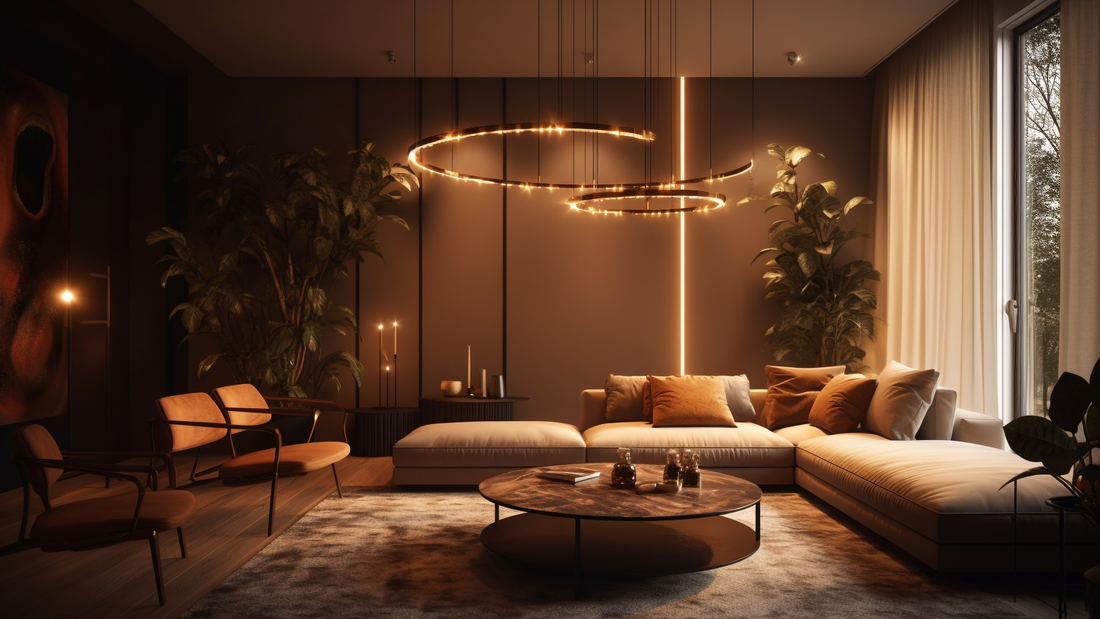
The Psychology of Warm vs. Cool Light (And When to Use Each)
The Psychology of Warm vs. Cool Light (And When to Use Each)
Ever notice how you feel completely different under the fluorescent lights at Target versus the cozy glow of a restaurant? That's not in your head - light literally changes how we feel, think, and even how attractive we look to others.
I used to think light was just light. Bright or dim, that was it. Then I swapped out the cool white bulbs in my bedroom for warm ones and suddenly I actually wanted to spend time in there. Turns out our brains are way more sensitive to light color than most of us realize.
What We're Actually Talking About
When we say "warm" and "cool" light, we're talking about color temperature, measured in Kelvins. Lower numbers = warmer (more yellow/orange). Higher numbers = cooler (more blue/white).
- Warm: 2700K-3000K (think candlelight to sunset)
- Neutral: 3500K-4000K (natural daylight)
- Cool: 5000K-6500K (cloudy day to bright white)
Your brain processes these differently, and the effects are pretty wild when you know what to look for.
Warm Light: The Comfort Zone
Warm light tricks your brain into relaxation mode. It mimics the golden hour and firelight - things humans have associated with safety and winding down for thousands of years.
What it does to you:
- Lowers stress hormones
- Makes you feel more social and connected
- Reduces eye strain
- Signals your body to start producing melatonin
- Makes skin tones look healthier and food look more appetizing
Where it works best:
- Bedrooms (obviously - you want to sleep, not feel alert)
- Living rooms where you hang out and relax
- Dining rooms (warm light makes everything look more delicious)
- Bathrooms in the evening (helps you wind down for bed)
I switched my living room to all warm bulbs last year and suddenly people started staying longer when they came over. Coincidence? I don't think so.
Cool Light: The Productivity Hack
Cool light is like coffee for your brain. It suppresses melatonin and tells your body it's time to be alert and focused.
What it does to you:
- Increases alertness and concentration
- Boosts mood during the day
- Helps with detailed tasks
- Reduces seasonal depression symptoms
- Makes colors appear more vibrant and true
Where it works best:
- Home offices (you want to be sharp, not sleepy)
- Kitchens during the day (for food prep and cleaning)
- Bathrooms in the morning (wake yourself up)
- Craft rooms or anywhere you do detailed work
- Closets (so you can actually see what colors you're wearing)
My friend Sarah put cool lights in her home office and said she stopped getting that 2 PM brain fog. The difference was that dramatic.
The Timing Thing Nobody Mentions
Here's where it gets really interesting - the same room might need different light at different times.
Your circadian rhythm expects cool light in the morning and warm light in the evening. Fight this, and you'll feel off even if you can't pinpoint why.
Morning routine: Start with cooler lights to wake up your brain Evening routine: Switch to warm lights 2-3 hours before bed
This is why those harsh bathroom lights feel so wrong at night. You're literally telling your brain to wake up when you want to wind down.
The Mood Connection
Different light colors actually change how we perceive spaces and people:
Warm light makes:
- Rooms feel smaller and cozier
- People look more approachable
- Food look more appetizing
- Conversations feel more intimate
Cool light makes:
- Rooms feel larger and cleaner
- Details more visible
- Colors more accurate
- The space feel more professional
This is why restaurants use warm light (you linger longer and order more) while retail stores use cool light (everything looks fresh and you can see details clearly).
When to Break the Rules
Sometimes the "right" choice doesn't work for your life:
- If you work night shifts, you might need cool light in your bedroom during the day
- If you have seasonal depression, cool light in the living room might help more than ambiance
- If you're doing hobbies that need color accuracy, cool light wins over mood
The Easy Way to Test This
Before you rewire your entire house, try this: Get a couple of smart bulbs that change color temperature. Spend a week with warm light in your bedroom, then switch to cool. Notice how differently you feel falling asleep and waking up.
Do the same experiment in your workspace. I guarantee you'll notice the difference.
Mixed Lighting: The Best of Both
You don't have to choose just one. Layer different color temperatures:
- Cool task lighting for when you need to focus
- Warm ambient lighting for when you want to relax
- Use dimmer switches so you can adjust throughout the day
My kitchen has cool under-cabinet lights for cooking and warm pendant lights for dinner. Best of both worlds.
The Bottom Line
Light color isn't just about style - it's about how you want to feel in each space. Cool light energizes, warm light soothes. Use this to your advantage instead of accidentally working against your own mood all day.
Your future self (who actually sleeps well and feels productive) will thank you.
Ready to experiment with light temperature? Check out our collection of adjustable and smart lighting options that let you customize the mood of any room.
